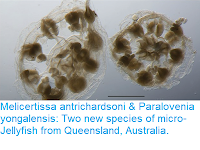Burrowing Sea Anemones, Edwardsiidae, are curious Cnidarians with highly modified bodies. Whereas other Sea Anemones are sessile creatures that typically spend their entire adult lives attached to a hard substrate (they have a brief planktonic larval stage), Burrowing Sea Anemones have elongate Worm-like bodies and are capable of tunnelling through mud, sand, rock crevices, and even ice. Burrowing Sea Anemones have eight mesenteries (longitudinal internal divisions), the same as larval Anemones but in contrast to all other adult Anemones, which usually have twelve. For this reason they were for a long time thought to be primitive members of the group, potentially similar to the ancestors of other Anemones. However, the advent of genetic phylogenies have shown this not to be the case, with the Burrowing Anemones shown to be highly derived members of the group, with the reduction in adult mesenteries apparently an adaptation to a their burrowing lifestyle.
In a paper published in the journal ZooKeys on 1 November 2018, Takato Izumi and Toshihiko Fujita of the Department of Biological Sciences at the University of Tokyo, and the Department of Zoology at the National Museum of Nature and Science, describe three new species of Burrowing Sea Anemones from Japan; all of which are placed in the genus Scolanthus, which has not previously been described from Japanese waters.
The first new species is named Scolanthus ene, in reference to the area where it was discovered. The species is described from a single specimen collected from intertidal mudflats in Ene Bay, in Kanagawa Prefecture. This specimen is about 80 mm in length and 10-15 mm in width, and is orange in colour. It has twenty tentacles set into two rows; these are 7-10 mm in length, with those of the outer ring longer than those of the inner ring.
The first new species is named Scolanthus ene, in reference to the area where it was discovered. The species is described from a single specimen collected from intertidal mudflats in Ene Bay, in Kanagawa Prefecture. This specimen is about 80 mm in length and 10-15 mm in width, and is orange in colour. It has twenty tentacles set into two rows; these are 7-10 mm in length, with those of the outer ring longer than those of the inner ring.
Whole living specimen of Scolanthus ena. Te, tentacle. Scale bar is 5 mm. Izumi & Fujita (2018).
The second new species is named Scolanthus isei, in honour of Yuji Ise, who collected the two specimens from which the species is described. These specimens were collected from crevices in rocks that were 30 and 50 cm below sealevel at low tide, on the southwest coast of Sugashima Island, off the east coast of central Honshu. The lager of these are about 30 mm in length, and 10-12 mm in width, the smaller being about 18 mm in length and 9 mm in width. They are rather tubby in form for a Burrowing Anemone, with a rough, uneven skin, and are brownish or whitish in colour, with twelve tentacles 5-7 mm in length arranged in two rings; eight on the inner ring and twelve on the outer.
Whole specimen of Scolanthus isei. Ne, nemathybome; TP, trichome-like structure on periderm. Scale bar is 5 mm. Izumi & Fujita (2018).
The third new species is named Scolanthus kopepe, in reference to the Kopepe Coast of Chichijima Island in the Ogasawara Group, where it was discovered (the term Kopepe refers to the indigenous people of the Ogasawara Islands). The species is described from a series of specimens collected from coraline sand on the island , at depths of up to sevne metres. these are 15-25 mm in length and 1-2 mm in width, smooth skinned and white or pale yellow in colour. This species has 16 tentacles sorted into two rings, with eigh tentacles on each ring and the inner ring being made up of smaller tentacles than the outer.
See also...
Living specimen of Scolanthus kopepe. Izumi & Fujita (2018).
Follow Sciency Thoughts on Facebook.









